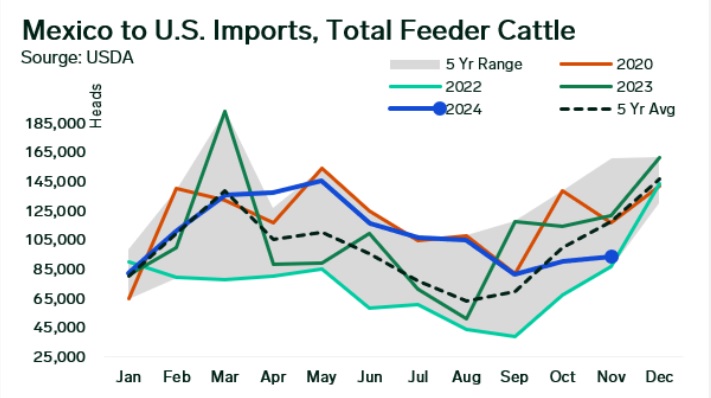
From Livestock to Lineups: Mexico Faces New US Trade Barriers
The Shifting Sands of US-Mexico Trade
Let's be honest, international trade is rarely straightforward. It's a complex dance of negotiations, tariffs, and – let's not forget – the occasional political squabble. Right now, Mexico is feeling the heat, facing a new wave of trade barriers imposed by its northern neighbor, the United States. This isn't just about tariffs on avocados (though those are always a drama!). We're talking about a wider impact, spanning from livestock to – well, pretty much everything. Think of it as a domino effect, with one trade barrier potentially toppling many others.
From Cattle to Cars: A Broad Spectrum of Impacts
The new barriers aren't targeted at just one specific product. It's a diverse range of goods, encompassing everything from agricultural products like livestock and produce to manufactured goods. Imagine the ripple effect: higher prices for consumers in the US, reduced profits for Mexican producers, and a general chilling effect on the overall trade relationship. It's not a pretty picture.
The Livestock Lament: A Sector Under Siege
One of the areas feeling the biggest sting is the Mexican livestock industry. New regulations and increased scrutiny on imports of cattle and other livestock products have created significant hurdles for Mexican exporters. This isn't simply a matter of paperwork; the delays and added costs can cripple businesses, particularly smaller producers who lack the resources to navigate this complex new landscape. This is particularly problematic given the historical strength of the Mexican livestock sector, which had found a healthy market in the United States.
Beyond the Barnyard: The Broader Economic Fallout
But the problems extend far beyond the barnyard. The impact of these trade barriers reaches into nearly every sector of the Mexican economy. The automotive industry, a major contributor to Mexico's GDP, is facing increased challenges with new rules surrounding the origin of components. This means Mexican manufacturers might struggle to meet the requirements for preferential trade treatment, potentially leading to higher costs and reduced competitiveness. It's a tough pill to swallow for an industry that has long been a key player in the North American supply chain.
From Livestock to Lineups: The Human Cost
From Livestock to Lineups: Mexico Faces New US Trade Barriers isn't just an economic issue; it's also a human one. The increased trade barriers can lead to job losses, reduced incomes, and increased economic hardship for Mexican families. This isn't some abstract economic theory; it's about real people whose livelihoods are directly affected by these policy decisions. Think about the farmers who can no longer export their products, the factory workers who lose their jobs, and the families who struggle to make ends meet. The consequences are deeply felt at the grassroots level.
Navigating the New Normal: Strategies for Survival
So, what can Mexico do? The country needs to implement a multi-pronged strategy to address these new trade challenges. This could include:
- Diversifying export markets: Reducing reliance on the US market by exploring opportunities in other countries.
- Improving efficiency and productivity: Reducing production costs to remain competitive.
- Investing in technology and innovation: Improving the quality and competitiveness of goods.
- Strengthening diplomatic ties: Negotiating with the US to address specific concerns.
The Long Game: Rebuilding Trust and Trade
The current situation is far from ideal, but it presents an opportunity for both countries to re-evaluate their trade relationship. Open dialogue and a commitment to finding mutually beneficial solutions are crucial. It's not about winning or losing; it's about creating a sustainable and equitable trading environment that benefits both Mexico and the US. This is a long-term project, requiring patience, persistence, and a real commitment to finding common ground.
From Livestock to Lineups: Mexico Faces New US Trade Barriers - A Conclusion
The new trade barriers imposed by the US are a significant challenge for Mexico, impacting various sectors of its economy and having a direct effect on the livelihoods of many Mexicans. While the situation is serious, it's not insurmountable. With strategic planning, proactive adaptation, and a willingness to engage in constructive dialogue, Mexico can navigate these challenges and emerge stronger. The key lies in finding solutions that create a win-win situation for both nations, ensuring a robust and healthy trade relationship for years to come.
Frequently Asked Questions
Q: What are the main reasons behind the new US trade barriers?
A: The reasons are complex and multifaceted, often involving concerns about fair competition, labor practices, and environmental regulations. Often, these are driven by internal political pressures within the US.
Q: How significantly will these barriers affect the Mexican economy?
A: The impact will vary depending on the sector, but it's expected to cause at least some economic slowdown and disruption, particularly in export-oriented industries. The full extent of the impact remains to be seen.
Q: What steps can Mexico take to mitigate the negative effects of these barriers?
A: Diversifying export markets, improving productivity, investing in technology, and engaging in diplomatic negotiations are all crucial strategies to lessen the blow.
Q: Could these barriers escalate into a larger trade conflict?
A: That's a possibility. The current situation depends heavily on how both countries handle the issue through diplomacy and trade negotiations. Escalation is a real risk, but not a guaranteed outcome.
Q: What is the long-term outlook for US-Mexico trade relations?
A: The long-term outlook is uncertain, but depends significantly on the willingness of both countries to find mutually beneficial solutions and manage the challenges constructively. The future of the relationship hinges on effective communication and compromise.




Post a Comment